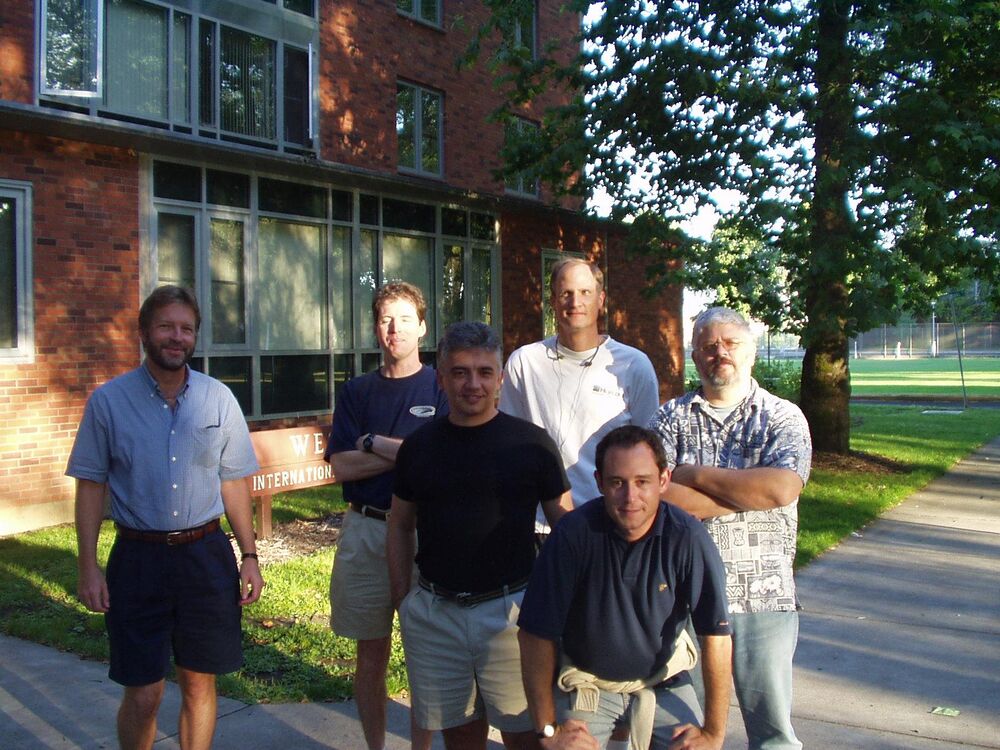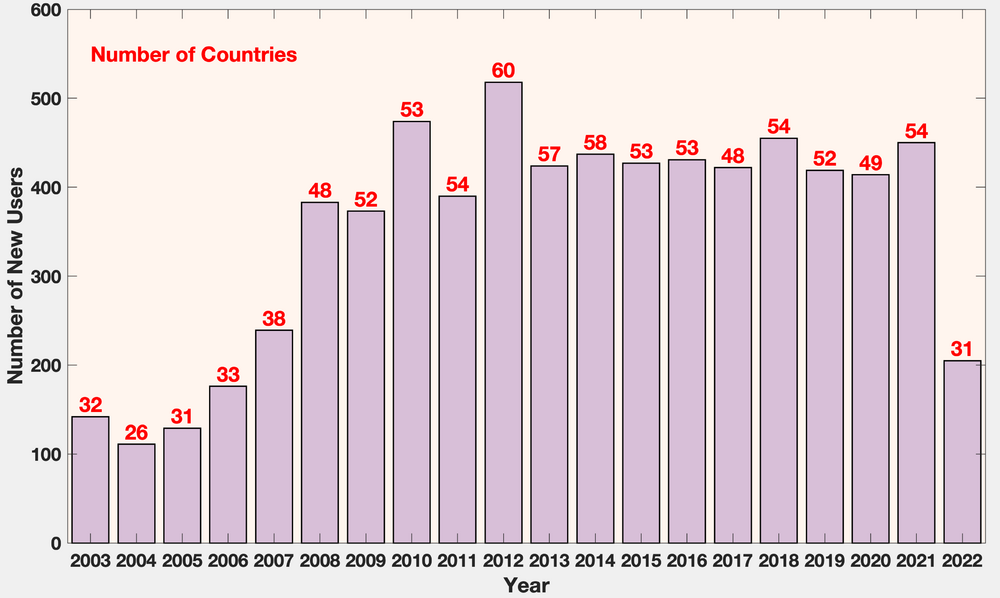Regional Ocean Modeling System (ROMS)
In the fall of 1995, Hernan G. Arango (hereafter HGA) started working at the Ocean Modeling Lab (OML), Institute of Marine and Coastal Sciences (IMCS), Rutgers University. His first assignment from OML's group leader Dale B. Haigvogel (hereafter DBH) was to work on the classic baroclinic, wind-driven, double gyre problem with the now-extinct S-Coordinate Rutgers University Model (SCRUM, Song and Haidvogel, 1994), which was derived from SPEM (Semi-spectral Primitive Equation Model; Haidvogel et al., 1991). The double-gyre application is affectionately known as Big Bad Basin (nowadays, BASIN test case) by several OML modelers because of its stability issues in long simulations. After a couple of months of struggling with the BASIN problem, HGA decided to rewrite SCRUM from scratch and modify its numerical kernel, including time-stepping, advection schemes, and implementing a split-explicit treatment coupling between barotropic (fast) and barotropic (slow) governing equations in collaboration with OML's scientists Robert J. Chant and Katherine S. Hedström. In addition, a complete overhaul of the model metadata, input, and output files with NetCDF format. And voilà, the BASIN application ran successfully for several years. The new model became SCRUM version 3.0, which later evolved to SCRUM 4.0 and then becomes the Regional Ocean Modeling System (ROMS). The acronym ROMS was inspired by the Regional Atmospheric Modeling System (RAMS). Thus, at the time, there was a regional numerical model for the atmosphere and ocean with similar acronyms.
In 1998, James C. McWilliams (hereafter, JCM) started looking for a regional ocean model for the U.S. West Coast and contacted DBH for possible collaborations. As a result, DBH and HGA traveled to Los Angeles, to meet at University of California, Los Angeles (UCLA) with JCM and Alexander F. Shchepetkin (hereafter AFS) or just Sasha, as the ROMS VIPs know him. The expectation that HGA and AFS would get along was very low. However, their mutual respect, skills, and friendship grew. As a result, and to the benefit of the ocean modeling community, ROMS was officially born. Their first task was to improve its efficiency by implementing a multi-threaded parallel version of its numerical kernel using the shared-memory paradigm native to the IRIX operating system available on SGI supercomputers of the time. The shared-memory compiling directives evolved later to the portable OpenMP standard implementation in ROMS. Moreover, AFS began looking at the ensemble code and started counting operations; multiplications replaced unnecessary divisions when appropriate, and DO-loops were reorganized and pipelined to reduce memory hits. HGA learned how to count operations and analyzed optimized Fortran code, which was available at the time, to minimize the need for automatic optimization. As a result, the ROMS code was very efficient and fast. Nowadays, ROMS can be compiled with aggressive Fortran optimization flags. Of course, users need to be aware that the bold optimization flags in some compilers could compromise the numerical IEEE floating-point precision, and new flags are required to retain it, which may slow down the computations.
In 2000, Terri Paluszkiewicz from the Office of Naval Research (ONR) approached HGA and JCM about funding opportunities to develop the next generation of a regional, high-resolution ocean model with accurate numerical algorithms and data assimilation capabilities. As a result, ONR started funding ROMS development separately to Rutgers (data assimilation and adjoint-based algorithms, applications, maintenance, and community outreach) and UCLA (numerical algorithms and applications). Then, HGA suggested to ONR that a redesign of ROMS was required, and a team of experts was needed to do variational data assimilation correctly. During his years at Harvard, HGA had the opportunity to meet Andrew M. Moore (hereafter, AMM), now at the University of California, Santa Cruz (UCSC), and work with Arthur J. Miller (hereafter, AJM) from the Scripps Institute of Oceanography (SIO). AMM is an expert on adjoint-based modeling and applications. Therefore, the ROMS data assimilation team included AMM, HGA, AJM, collaborator Bruce D. Cornuelle (hereafter, BDC), and Ph. D. student Emanuele Di Lorenzo (hereafter, EDL), and Douglas J. Neilson (Hereafter, DJW). ONR also funded UCSC and SIO separately for this work. Thus, it started a very successful collaboration with several peer-reviewed publications in journals and books. The chemistry between the ROMS Data Assimilation (ROMS-DA) group was extraordinary, with lots of fun, good food, and great wine-tasting parties.

AMM and HGA frequently traveled to Scripps, in La Jolla, for an intense week-long perturbation, tangent linear model (TLM) and adjoint model (ADM) code writing. AMM was the master teaching and directing the monkies on how to write ROMS-TL and ROMS-AD codes. The TLM and ADM were hand-coded from the discrete nonlinear (NLM) code using the recipes of Giering and Kaminski (1998). Therefore, any change to its dynamical and numerical kernels will affect the symmetry of the TLM and ADM operators. Moreover, the resulting discrete adjoint is exact and is defined relative to the inner product that prescribes the L2-norm. The finite-amplitude, tangent linear code for the Representer model (RPM) was later derived from the TLM. The RPM is used in the indirect, representer-based approach for 4-Dimensional Variational (4D-Var) data assimilation.
To be continued ...
ROMS Releases
The following table shows information about the infrequent tagged ROMS releases showing its evolution and expansion. It was redesigned completely starting with version ROMS 2.0 and written in Fortran-1990 standard with modules with the derived-type objects with dynamical allocation, and managed with svn repositories instead of cvs. Some features of Fortran-1995 and Fortran-2003 standards were introduced later when available in mostly all compilers. The perturbation Tangent Linear Model (TLM), finite-amplitude Tangent Linear (Representer) Model (RPM), and adjoint model (ADM) were released in version ROMS 2.3.
Tag Version svn Revision Release Date Number of Files Lines of Code 1.1.0 cvs -r 1.1.0 1999-01-20 125 44,639 1.2.0 cvs -r 1.2.0 1999-01-25 130 46,905 1.3.0 cvs -r 1.3.0 1999-03-15 131 47,931 1.4.0 cvs -r 1.4.0 1999-06-20 146 49,466 1.5.0 cvs -r 1.5.0 2000-02-10 145 56,118 1.6.0 cvs -r 1.6.0 2000-01-29 144 56,066 1.6.1 cvs -r 1.6.1 2000-03-06 144 56,123 1.6.2 cvs -r 1.6.2 2000-03-17 144 56,283 1.7.0 cvs -r 1.7.0 2001-01-19 165 63,652 1.7.1 cvs -r 1.7.1 2001-02-01 165 63,573 1.7.2 cvs -r 1.7.2 2001-04-17 173 66,324 1.8.0 cvs -r 1.8.0 2002-01-11 175 67,999 2.0 2 2003-06-30 232 95,836 2.1 3 2004-05-05 253 117,956 2.2 4 2005-05-26 297 158,176 2.3 8 2007-02-06 1,122 399,457 3.0 36 2007-04-27 1,313 460,643 3.1 166 2008-03-17 1,345 470,110 3.2 338 2009-03-25 1,428 549,318 3.3 432 2009-12-26 1,559 603,578 3.4 550 2011-04-19 1,583 643,878 3.5 568 2011-09-21 1,582 648,098 3.6 656 2013-04-18 1,638 684,351 3.7 974 2019-07-25 1,784 844,948 3.8 995 2020-01-09 1,799 848,245 3.9 1054 2021-03-06 1,909 884,508 4.0 1108 2022-02-25 1,985 1,066,953 current 1123 2022-04-25 1,989 1,079,102
On May 7, 2022, ROMS had 6970 registered users at www.myroms.org. The histogram below shows the number of new ROMS users per year and the number of countries (red values on top of the bar) where the new users reside. The tally was started when ROMS 2.0 was released on June 30, 2003.

ROMS Selected References
The following is an alphabetic list of essential publications describing various aspects of the ROMS algorithms:
- Di Lorenzo, E., A. M. Moore, H. G. Arango, B. D. Cornuelle, A. J. Miller, B. Powell, B. S. Chua, and A. F. Bennett, 2007: Weak and strong constraint data assimilation in the inverse Regional Ocean Modeling System (ROMS): Development and application for a baroclinic coastal upwelling system, Ocean Modelling, 16, doi:10.1016/j.ocemod.2006.08.002.
- Haidvogel, D. B., H. G. Arango, K. Hedstrom, A. Beckmann, P. Malanotte-Rizzoli, and A. F. Shchepetkin, 2000: Model evaluation experiments in the North Atlantic Basin: Simulations in nonlinear terrain-following coordinates, Dyn. Atmos. Oceans, 32, 239-281. (PDF)
- Fennel, K., J. Wilkin, J. Levin, J. Moisan, J. O'Reilly, and D. Haidvogel, 2006: Nitrogen cycling in the Middle Atlantic Bight: Results from a three-dimensional model and implications for the North Atlantic nitrogen budget, Global Biogeochem. Cycles, 20, GB3007, doi:10.1029/2005GB002456. (PDF)
- Gurol, S., A. T. Weaver, A. M. Moore, A. Piacentini, H. G. Arango, and S. Gratton, 2014: B-preconditioned minimization algorithms for variational data assimilation with the dual formulation, Q. J. R. Meteorol. Soc., 140, 539-556, DOI:10.1002/qj.2150.
- Levin, J., H.G. Arango, B. Laughlin, E. Hunter, J. Wilkin, and A.M. Moore, 2020: Observation impacts on the Mid-Atlantic Bight front and cross-shelf transportin 4D-Var ocean state estimates: Part I – Multiplatform Analysis, Ocean Modelling, 157, doi:10.1016/j.ocemod.2020.101721.
- Moore, A.M. and H.G. Arango, 2021: On the behavior of ocean analysis and forecast error covariance in the presence of baroclinic instability, Ocean Modelling, 157, doi:10.1016/j.ocemod.2020.101733.
- Moore, A.M., J. Levin, and H.G. Arango, and J. Wilkin, 2021: Assessing the performance of an ocean observing, analysis and forecast System for the Mid-Atlantic Bight using array modes, Ocean Modelling, 164, doi:10.1016/j.ocemod.2021.101821
- Levin, J., H.G. Arango, B. Laughlin, E. Hunter, J. Wilkin, and A.M. Moore, 2021: Observation impacts on the Mid-Atlantic Bight front and cross-shelf transport in 4D-Var ocean state estimates: Part II - The Pioneer Array, Ocean Modelling, 157, doi:10.1016/j.ocemod.2020.101731.
- Moore, A. M., H. G. Arango, A. J. Miller, B. D. Cornuelle, E. Di Lorenzo and D. J. Neilson, 2004: A Comprehensive Ocean Prediction and Analysis System Based on the Tangent Linear and Adjoint Components of a Regional Ocean Model, Ocean Modelling, 7, 227-258. (PDF)
- Moore, A.M., H.G. Arango, G. Broquet, B.S. Powell, A.T. Weaver, and J. Zavala-Garay, 2011: The Regional Ocean Modeling System (ROMS) 4-dimensional variational data assimilation systems, Part I - System overview and formulation, Progress in Oceanography, 91, 34-49.
- Moore, A.M., H.G. Arango, and G. Broquet, C. Edwards, M. Veneziani, B.S. Powell, D. Foley, J. Doyle, D. Costa, and P. Robinson, 2011: The Regional Ocean Modeling System (ROMS) 4-dimensional variational data assimilation systems, Part II: Performance and application to the California Current System, Progress in Oceanography, 91, 50-73.
- Moore, A.M., H.G. Arango, and G. Broquet, C. Edwards, M. Veneziani, B.S. Powell, D. Foley, J. Doyle, D. Costa, and P. Robinson, 2011: The Regional Ocean Modeling System (ROMS) 4-dimensional variational data assimilation systems, Part III: Observation Impact and Observation Sensitivity in the California Current System, Ocean Modelling, 91, 74-94.
- Moore, A.M., H.G. Arango, C.A. Edwards, 2017: Reduced-Rank Array Modes of the California Current Observing System, J. Geophys. Res. Ocean, 122, doi:10.1002/2017JC013172.
- Moore, A.M., J. Zavala-Garay, H.G. Arango, C.A. Edwards, J. Anderson, and T. Hoar, 2020: Regional and basin scale applications of ensemble adjustment Kalman filter and 4D-Var ocean data assimilation systems, Progress in Oceanography, 189, doi:10.1016/j.pocean.2020.102450.
- Shchepetkin, A. F., and J. C. McWilliams, 2003: A method for computing horizontal pressure-gradient force in an oceanic model with a nonaligned vertical coordinate, J. Geophys. Res., 108 (C3), 3090, doi:10.1029/2001JC001047. (PDF)
- Shchepetkin, A. F., and J. C. McWilliams, 2005: The Regional Ocean Modeling System: A split-explicit, free-surface, topography following coordinates ocean model, Ocean Modelling, 9, 347-404. (PDF)
- Shchepetkin, A. F., and J. C. McWilliams, 2008: Computational kernel algorithms for fine-scale, multi-process, long-time oceanic simulations. In: Handbook of Numerical Analysis: Computational Methods for the Ocean and the Atmosphere, eds. R. Temam & J. Tribbia, Elsevier Science, ISBN-10: 0444518932, ISBN-13: 978-0444518934.
- Shchepetkin, A. F., 2015: An Adaptive, Courant-number-dependent Implicit Scheme for Vertical Advection in Oceanic Modeling, Ocean Modelling, 91, 38-69, doi:10.1016/j.ocemod.2015.03.006.
- Warner, J. C., Z. Defne, K. Hass, and H. G. Arango, 2013: A wetting and drying scheme for ROMS, Computers & Geosciences, 58, 54-61, 10.1016/j.cageo.2013.05.004.
- Warner, J.C., W.R. Geyer, and H.G. Arango, 2010: Using composite grid approach in complex coastal domain to estimate estuarine residence time, Computer and Geosciences, 36, 921-935, doi:10.1016/j.cageo.2009.11.008.
- Warner, J. C., C. R. Sherwood, R. P. Signell, C. K. Harris, and H. G. Arango, 2008: Development of a three-dimensional, regional, coupled wave, current, and sediment-transport model, Computers & Geosciences, 34, 1284-1306.
- Warner, J. C., C. R. Sherwood, H. G. Arango, and R. P. Signell, 2005a: Performance of four turbulence closure methods implemented using a generic length scale method, Ocean Modelling, 8, 81-113. (PDF)
- Wilkin, J. L., 2006: The summer time heat budget and circulation of southeast New England shelf, J. Phys. Oceanog., 36, 1997-2011. (PDF)